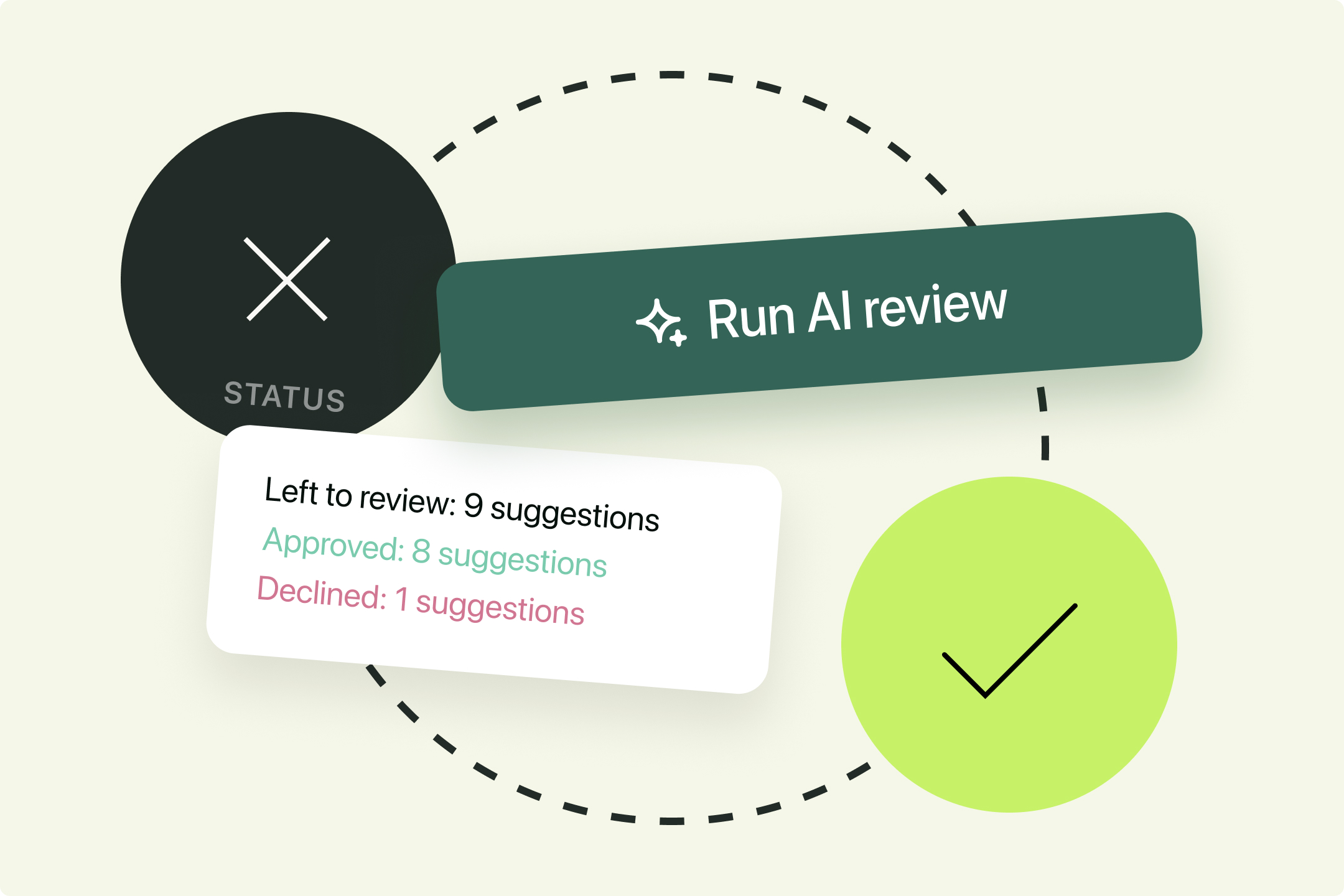Solutions
Customer Support
Resources
Negotiation has become glamourized in recent years. Popular TV shows would lead us to believe that successful contract negotiations are about forcing opponents into submission, or worse, blackmailing them until you get what you want.
But contract negotiation in the real world couldn’t be more different. In fact, the best strategies for negotiating contracts actually rely upon empathy, creativity, and the ability to listen - a far cry from the scenes we see in media.
But what does negotiating contracts successfully actually entail, and which contract negotiation strategies will help you reach equitable outcomes for all? This guide answers all of these questions, and more.
A contract negotiation strategy is an approach used when negotiating legal agreements, with the goal of securing the outcome you want for yourself or your client. Unfortunately, there’s no single trick to help you succeed in every negotiation.
There are, however, multiple different strategies you can adopt to give you the best chance. That’s why we’ve compiled a list of the 13 best contract negotiation strategies below to help you get signatures on contracts faster and with the most optimal terms.
The first contract negotiation strategy should go without saying, but we’ll mention it here anyway. Don’t enter a negotiation without anything to negotiate. One of the biggest mistakes sales teams can make is negotiating the terms of relationship before these have been laid out within a contract.
That’s why it’s essential to always start negotiations with a draft of the contract. This doesn’t have to be perfect, and it’s normal for first drafts of an agreement to become littered with redlines and comments.
In fact, creating a simple contract and framing the key principles within it will actually reduce the time spent deliberating over what the final terms should look like, as it provides a starting point for these discussions.
However, this doesn’t mean you should set out terms that exclusively favour you. You should still be realistic and considerate with the terms you lay out, as this can reduce friction later on in the process.

A common frustration in negotiations is receiving pushback from the individual negotiating the contract with you, not because they aren’t willing to accept your proposition, but because they don’t have the authority to do so.
One of the best contract negotiation strategies used to eliminate this back and forth is to identify who the real decision maker is and invite them to negotiate instead. However, it’s important to do this politely and without dismissing the person you’re dealing with already.
This can be achieved by setting up approval workflows that enable parties to add a sequence of approvers to a contract.
This will help to accelerate legal review without bypassing senior contract stakeholders, as they will automatically be prompted to provide their approval when workflows are set using a contract tool like Juro.

Ask yourself: what do we want to achieve from this negotiation? Are you looking to reduce the price you pay for a product or service? Are you to reduce the contract duration, or maybe even extend it?
Irrespective of what you’re seeking to gain from contract negotiations, this should remain at the forefront of your mind throughout.
Consider what your core objectives as a business are, and how you can advance these key interests within the contract terms. You should also consider how important these are to you, and where you might be willing to concede one to prioritize another.
It’s important to recognize that the sole purpose of negotiating isn’t just to win. It’s to form better business relationships and make progress on the issues that matter most in your organization.
Contract negotiations can be overwhelming, particularly for detailed and complex contracts. That’s why most of the best contract negotiation strategies revolve around structure.
One of the biggest mistakes legal and business teams make when entering into negotiations is eagerly trying to negotiate a cluster of different points of conflict all at once.
What happens next? Well, usually both parties walk away from the negotiation feeling frustrated, ignored and confused about the progress made.
It’s far more efficient to break the contract down into different components and address these methodically. That way, you can ensure each point of friction has been addressed and resolved before moving onto the next.
It also helps to avoid the ‘all-or-nothing’ approach to negotiations that often see contract negotiations breakdown unnecessarily over minor points of conflict.

Research is essential for every stage of the prospecting and selling process, and contract negotiations are no exception.
For example, if you’re selling a contract management tool, you’ll likely benefit from knowing how long the contracting process is taking the business currently, what costs they’ve incurred as a result of this and how these might scale as the company continues to grow.
This research may provide you with leverage in the negotiation, and it can help to ensure that you’re more receptive to the other party’s needs and pain points when proposing solutions.
It’s common to attach emotion to certain deals, especially when you’ve been nurturing them for a long time.
However, it’s important not to let your personal feelings take over when negotiating a contract. Rather than focusing on how certain objections make you feel, you should place emphasis on the facts of the situation instead.
This is because emotions can distract us from the most substantive matters within a negotiation. They can also make us more susceptible to manipulation and hinder our rational thought process. This can make it even more challenging to gain what the business needs from a negotiation.
Contract negotiations can also lose momentum when they reach a particular sticking point. For SaaS contracts, this could be that the prospect has certain reservations about the security or technical aspects of the software being sold, or because they’re concerned about how the software might comply with certain regulatory requirements.
The best thing to do in these instances is to accept that there may be someone better qualified to answer these high-level, technical questions than the sales team.
{{quote1}}
If a prospect has concerns about the reliability of the software for whichever reason, invite them to join a call with a member of the product team who can put these concerns to bed. Similarly, if the question is about legal and compliance issues, it’s likely a good time to bring the legal team into negotiations (if they aren’t already involved).
Another important tip for negotiating a contract is to establish your non-negotiables from the offset. Perhaps there is a certain threshold on the pricing that’s been set by the finance department or certain clauses on the limitations on liability that legal teams aren’t willing to remove.
Whatever it is, it’s important to stand firm on these, as any flip-flopping could cause prospects to assume that there’s flexibility around certain terms - even if there isn’t.
Setting up a deal desk is an effective way to understand when you can move the goal posts and when you can’t. Deal desks invite all of the relevant stakeholders to discuss certain business contracts, allowing them to provide their input on certain elements of a deal, such as pricing, timings, and contract terms.
There's also a framework called Best Alternative to a Negotiated Agreement (BATNA) that could prove useful. This is something businesses should prepare before entering into negotiations, and it's a contract negoitation strategy that determines the next best course of action when a negotiation fails.

One of the most obvious contract negotiation strategies - but often most neglected - is active listening.
Listening to and understanding counterparties also provides scope for more creative solutions within negotiation, and this can often be the difference between a contract getting signed or it not. It also demonstrates respect and enables you to provide clarification on specific points.
The best way to ensure you’re listening actively to the counterparty (and convey this) is to reframe what they say within your response, as well as asking relevant follow-up questions. That can look like this:
“You mentioned that you would not be able to approve the current pricing proposal. Would you be able to explain this decision in more detail so that I can better understand what your expectations are regarding pricing?”
Contract negotiation specialist, Laura Fredericks offers a great alternative, too:
"Are there changes you’ve previously approved to the limit of liability provisions that might also work here?”
Listening carefully to the concerns that the counterparty is voicing provides you with ample opportunity to find a deal that’s mutually beneficial. Neglecting their needs in favour of your own is more likely to lead you towards a dead-end.
One of the best strategies for negotiating a contract is to have a thorough understanding of the dynamics of a deal. This means thinking carefully about where each party stands and shaping the negotiation conversation in accordance with this.
To evaluate this, consider the following things:
Understanding where you stand within a contract negotiation is essential to success. If you’re unaware of these things, you could find yourself adopting an approach that works in some circumstances but not others.
Each deal is different, so let the deal dynamics inform your strategy.
One underrated contract negotiation strategy is to reflect on and learn from your previous experiences negotiating certain contracts. Perhaps you’ve closed deals with a similar customer in the past, or a customer that shared the same objections. How did you do it?
Reflecting on past experiences in negotiations can be a great way to move past sticking points and bring contracts closer to signing. It can also be a valuable learning curve about what hasn’t worked previously, and why.

This contract negotiation strategy is simple if you’re fortunate enough to have a data-rich contract repository to manage your contracts. Contracts stored within a tool like Juro can be queried in seconds, providing users with access to a wealth of contract data.
Using Juro, users can quickly identify contracts with similar contract values, jurisdictions, durations and terms. They can then review a timeline of changes for these contracts and observe both friction points and the most successful solutions.
Tensions can feel high during a negotiation, but that's no excuse to stop treating the counterparty as a respected partner in the relationship. In fact, being kind and human goes a lot way.
As Laura Frederick, contract negotiation specialist, explains:
{{quote2}}
And that's not too hard to imagine. The first impression of your organization can set the tone for the entire relationship, so make sure you get off on the right foot.
What most contract negotiation courses and tips don’t cover is how to improve the negotiation process by reducing the admin involved.
Most advice fixates on how what we say and how we say it can speed up the negotiation process. But it doesn’t discuss how reducing the manual tasks required during negotiations can achieve the same goal.
In most contract workflows, negotiation relies on multiple different tools. Contracts tend to be drafted in Word, saved as a PDF, shared via email, downloaded as a Word file again, redlined in that file, saved and then emailed back for review.

This process is repeated again and again until all parties have agreed to the terms listed. Receiving approval from senior stakeholders requires emailing them to request it, and signing contracts means either printing it out to sign in wet ink or using a separate eSignature tool to push it over the line.
Why is this a problem? Well, it’s time-consuming for a start. Lean legal teams in fast-growing businesses simply don’t have the time to manage contracts end-to-end in this way.
As contract volumes grow, this burden becomes even greater. It’s also incredibly inefficient and manual - for both parties. Moving between tools and managing multiple versions of the same contract is tedious.
Thankfully, it doesn’t have to be this way. One of the most overlooked contract negotiation strategies is implementing software that streamlines and facilitates the process to reduce unnecessary admin.
In fact, legal and business teams that use Juro typically win back 70% of time spent on contract admin. This creates a better negotiation experience for both sides.
Why not join the 6000+ companies that already power their contracts with Juro? Juro’s all-in-one contract automation platform helps visionary legal counsel and the teams they enable to agree and manage contracts in one unified workspace. Fill out the form below to find out more.
Lorem ipsum dolor sit amet, consectetur adipiscing elit. Suspendisse varius enim in eros elementum tristique. Duis cursus, mi quis viverra ornare, eros dolor interdum nulla, ut commodo diam libero vitae erat. Aenean faucibus nibh et justo cursus id rutrum lorem imperdiet. Nunc ut sem vitae risus tristique posuere.

